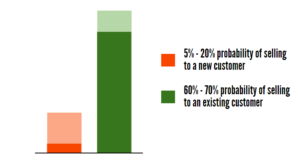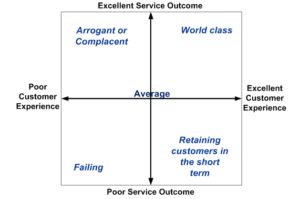 Many organizations think that the only way to grow their business is to find new customers. But often, the best source for growth is sitting right in front of you – existing customers.
Many organizations think that the only way to grow their business is to find new customers. But often, the best source for growth is sitting right in front of you – existing customers.
Finding new customers aids business growth but here’s an important fact: Studies show that the probability of selling to an existing happy customer is up to 14x higher than the probability of selling to a new customer.

Figure 1
Hence it makes perfect sense to take care of your current customers first and make sure they are happy. When they are happy, they’ll recommend your organization to their friends. And because we trust people more than ads, as these recommendations continue to spread, we get better results than we do in expensive marketing campaigns.
This recommendation-driven growth activity is triggered and sustained by consistent excellent service that delights customers. And many organizations simply don’t provide it.
The implication is that if your organization does, you can make significant and sustainable gains in the marketplace. Hence service and service delivery can be, and increasingly are, a competitive weapon.
Your organization can compete on service outcome; on customer experience; or on both.
The service outcome is the result of the service for the customer, while the customer experience is the customer’s direct experience of the service process, which concerns the way an organization deals with or treats the customer.
For example, if a patient goes to the hospital, his state of health (whether he becomes well or not) after being attended to by the doctor is the service outcome. How courteous the nurses and doctors were, the hospital environment, waiting time, etc., make up the customer experience.

Figure 2
As Figure 2 above suggests, based of customer experience and service outcome, there are a number of positions that an organization may take up when compared with the competition.
The positions are as follows:
Failing (Poor Experience, Poor Outcome): The organization’s outcomes are below industry expectations and customer experience is poor. The telecoms industry in Nigeria has a good example – a government-owned telecoms national carrier that could not move with market trends after industry privatization. A typical example of an organization in failing quadrant, it offered poor outcome and poor experience and eventually failed.
Arrogant or Complacent (Poor Experience, Excellent Outcome): Organizations who find themselves in this quadrant provide excellent service outcomes but treat customers poorly. Knowledge-based professional services sometimes fall into this category. Knowing more than their clients, they often display arrogance thereby denting customers’ experience. The medical profession often comes in for criticism in this area, dealing with patients not as human beings but rather as another condition to be treated.
Retaining Customers in the Short Term (Excellent Experience, Poor Outcome): It is possible to provide excellent customer experience but give total service outcome that falls below standard. With this, the emotional switching costs for the customers are high but they will tolerate poor service outcome only for a relatively short time and eventually leave. Some technology companies have used this strategy to retain customers in the period between phasing out of an old product and launching of a new one.
Average: Average position is at the overall centre of the diagram. Some organizations are average.
Organizations in this position include high-volume business-to-consumer services in sectors having many reasonably established competitors, all conducting business in a similar fashion. The Nigerian universal banking sector is a good example. There are over twenty players but little to choose between them.
World Class (Excellent Experience, Excellent Outcome): These organizations are universally recognized as being the best in all they do. There are few of these in existence.
Organizations will find that they are positioned at different points in Figure 2. Some may be world class, some failing, and others in any of the other positions.
Key question to ponder: Where is your organization positioned?
The answer will depend on how well you do on both service outcome and customer experience. Currently, are you better at providing service outcome or are you better at providing customer experience? What level of outcome and experience are your competitors offering and where are they positioned?
The answers to some of these questions would help you to come up with a clear, compelling service strategy that can energize your organization and position you ahead of your competitors.